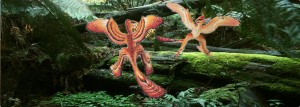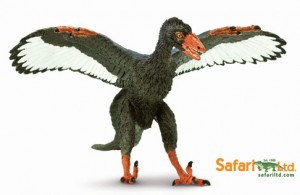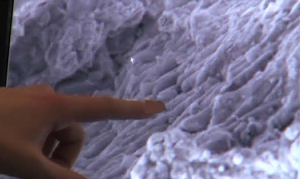Fossilised Feathers Helping to Identify the Colour of Dinosaurs – It’s a Bit of a Blur
Shape of Melanosomes and Hence Plumage of Dinosaurs Questioned
Over the last couple of years or so, a number of scientific institutions have published academic papers revealing evidence of melanosomes preserved in fossil specimens. As the shape and structure of these microscopic fossil features can provide evidence of the pigmentation and colour of an organism, the geometry of these melanin-loaded specialised elements within a cell, effectively acts as a colour chart for the animal the fossils represent.
Feathered Microraptors – Still Uncertain Regarding Colouration
Picture credit: Everything Dinosaur
The Colour of Dinosaurs
Perhaps one of the most famous fossils of all, material ascribed to the Late Jurassic transitional bird/reptile fossil known as Archaeopteryx (Archaeopteryx lithographica) has had melanosome evidence presented. In this case, a single feather preserved in the fine grained lithographic limestone of the area suggested that the tip of the feather may have been coloured black. The research was carried out in 2012 and undertaken by a team from Yale University, Brown University, the Carl Zeiss Laboratory (Germany) and the University of Akron (Ohio, United States).
Using extremely high-powered microscopy, the international research team identified the colour of a single fossilised feather, very likely from an Archaeopteryx. They concluded that the feather, most probably a wing feather was black at the tip. Their conclusions were based on the geometry (shape) of the remains of melanosome structures that they had observed.
To read more about the Archaeopteryx research: Archaeopteryx – Back in the Black
The Colour of Archaeopteryx Feathers
However, the colour of Archaeopteryx or any other animal in the fossil record with preserved evidence of melanosomes is not quite as “black and white” as it seems. A new paper, published in the scientific journal “Biology Letters” suggests that over millions of years, the shape and structure of the melanosomes can be distorted under heat and pressure and the fossilised shape may not have much of a resemblance to the structure of these pigmentation organelles when the organism was alive, and in the case of Archaeopteryx, flapping around.
Debate Likely to Continue over the Colour of Archaeopteryx
To view models and replicas of Archaeopteryx and other prehistoric animals: Wild Safari Prehistoric World Replicas.
Melanosomes Providing a Guide
The theory about melanosomes providing a guide to the colour of an extinct animal is on the surface very simple, but the trick, as with most aspects of palaeontology is the analysis of the data. Melanosomes contain melanin and these specialised cell structures are present in skin, hair and feather cells. The colour of the melanosome relates to a specific pigment.
Although the fossilisation process may have degraded all signs of actual colour, the ghostly shapes of the melanosomes themselves are often visible using specific lighting and optical devices such as high powered electron microscopes. The preserved size, layout and shape can give palaeontologists some suggestions about the original colour in the organism.
Maria McNamara et al (University of Bristol), have published a study which suggests that the properties of melanosomes preserved in such fossils as the remains of dinosaur feathers, could become distorted and therefore provide scientists with misleading clues as to the original colour. Under Professor Mike Benton (University of Bristol), some of the initial research into the colour of feathered dinosaurs was undertaken. Professor Benton, in collaboration with Chinese colleagues provided evidence of the first colouration of a member of the Dinosauria back in 2010, when it was announced that the cursorial Chinese Theropod Sinosauropteryx may have been ginger.
To read more about the potential colouration of dinosaurs: Ginger Dinosaurs?
Simulating the Fossilisation Process
Maria and her fellow researchers mimicked the fossilisation process of feathers by simulating burial by placing modern-day bird feathers into an autoclave and then subjecting them to temperatures in excess of 250 degrees Celsius. The chamber which held the experiment, was pressurised to 250 atmospheres, the intense heat and extreme pressures would be similar to the forces applied to strata and the fossils within them over millions of years.
When the melanosomes were studied under high magnifcation, the structure and shape of many of them had changed. In effect, they had become distorted and withered. This could lead to misinterpretations of fossil material if the melanosomes found preserved were taken at face value.
Black Feathers?
Ryan Carney, a research scientist based at Brown University, one of the team members who worked on the Archaeopteryx case study, black feathers and all, commented that shrinkage had been taken into account when he and his co-workers prepared their Archaeopteryx paper. Their black feather conclusion was based on observations made using hundreds of melanosome structures that the team studied under very high magnification. Although, the melanosomes may shrink a little during the fossilisation process, their original shape can still be determined by examining an imprint left in the matrix by the organelle (organelle – specialised area of a cell with specific functions).
Referring to the Archaeopteryx study he stated:
“We found that the length and width of melanosomes were significantly smaller compared to those of the imprints, the shrinkage was actually quite similar to that of the McNamara et al experiment”.
McNamara and her team remain confident in the validity of their data and they have provided intriguing evidence which requires careful analysis in the light of the current research. For example, another important conclusion from this research is that melanosomes survive the heat and pressure of fossilisation even after the destruction of other non-melanin colour traces such as carotenoids (organic pigments, responsible for example for the colour of carrots and apricots). Carotenoids can create vivid shades of orange, green, yellow, red and blue in feathers, however, in the University of Bristol experiments the multi-coloured feathers tested gave results indicating that they were just black. This was because their non-melanin organic pigments had been destroyed and only the melanosomes survived to give the false reading of black.
With this conclusion in mind, the discovery of melanosomes in a fossilised feather such as that from a 150 million year old specimen such as Archaeopteryx might not necessarily mean that the original feathers were coloured black, reddish or brown.
McNamara commented:
“The bottom line is that until we understand how the fossilisation process affects these colour-producing chemicals and structures, and until we know how to look for evidence of these in fossils, there’s really no point in attempting to reconstruct colour of feathers based on melanosomes alone.”
Being able to determine the colour of an extinct animal would be very helpful in trying to work out its behaviour or how it reacted to its environment. Knowing the true colour of a Velociraptor for instance, would enable palaeontologists to assess how it camouflaged itself or used visual signals to communicate with other members of its kind. If a number of fossil specimens of different aged individuals could be studied, scientists might be able to see how the colouration changed as the animal grew, what differences there may have been between males and females etc.
Examining a Highly Magnified Image Showing Melanosome Structures
Picture Credit: Brown University
The Archaeopteryx study also led to some conclusions related to the development of avian flight. The melanin in the wing feathers may not only have provided colouration but also helped to increased the strength of the feather, very helpful to have strong feathers with core strength if you are trying to evolve into a more active and efficient flier.
There is still so much to learn about fossils, new techniques and new areas of research are providing some astonishing data but we still have a long way to go before we can say definitively what colour a feathered dinosaur may have been.




